Panasonic Lumix G Vario 14-140mm f/3.5-5.6 Lens Review
Panasonic Lumix G Vario 14-140mm f/3.5-5.6 ASPH. HD Performance
Sharpness in the centre of the frame at 14mm and maximum aperture is already excellent, and the clarity toward the edges of the frame approaches very good levels. Stopping down improves sharpness slightly, but not by all that much, with similar performance being maintained until the lens is stopped down past f/11.With the lens zoomed to 50mm, performance is much the same as at 14mm, with sharpness being excellent in the centre fo the frame and very good towards the edges. In fact, this is one of the most consistent super-zoom lenses tested so far, as at 140mm, there is little to differentiate the performance here from that at other focal lengths.
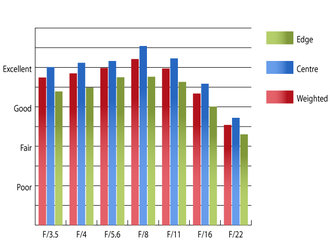 MTF @ 14mm | 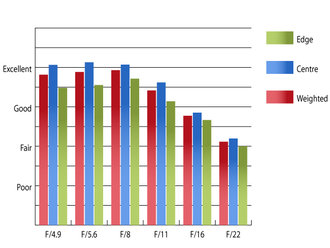 MTF @ 50mm |
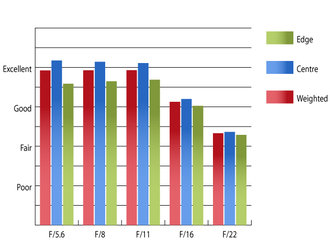 MTF @ 140mm | How to read our chartsThe blue column represents readings from the centre of the picture frame at the various apertures and the green is from the edges. Averaging them out gives the red weighted column.The scale on the left side is an indication of actual image resolution. The taller the column, the better the lens performance. Simple. For this review, the lens was tested on a Panasonic Lumix G3 using Imatest. |
For a 10x zoom lens, chromatic aberrations are very well controlled throughout the zoom range. Fringing is at its most prominent at 14mm, where it covers just short of 0.7 pixel widths. This amount of fringing may be visible in some situations, but is low enough not to cause too much concern.
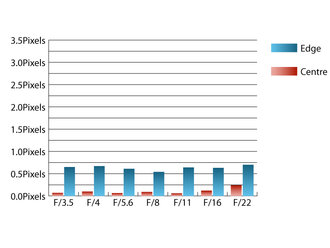 Chromatic aberration @ 14mm | 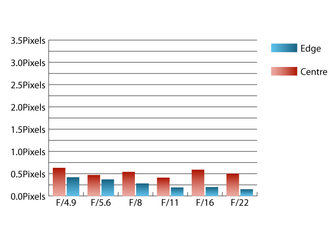 Chromatic aberration @ 50mm |
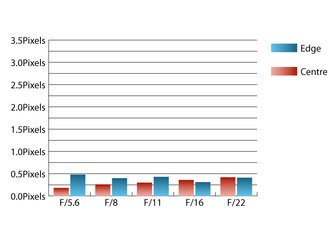 Chromatic aberration @ 140mm | How to read our chartsChromatic aberration is the lens' inability to focus on the sensor or film all colours of visible light at the same point. Severe chromatic aberration gives a noticeable fringing or a halo effect around sharp edges within the picture. It can be cured in software.Apochromatic lenses have special lens elements (aspheric, extra-low dispersion etc) to minimize the problem, hence they usually cost more. For this review, the lens was tested on a Panasonic Lumix G3 using Imatest. |
Falloff of illumination towards the edges of the frame is fairly well controlled throughout the zoom range. At 14mm the corners are 1.86 stops darker than the image centre at maximum aperture and at 140mm the corners are 1.58 stops darker. Visually uniform illumination is achieved with the aperture stopped down by one stop from maximum throughout the zoom range.
Distortion is extremely well controlled for such a superzoom lens. At 14mm Imatest detected 0.978% barrel distortion, and at 140mm this decreases to 0.01%. The distortion pattern remains constant across the frame throughout the zoom range, which should make corrections in image editing software afterwards relatively easy to apply although the amount of distortion present is so low, it will rarely need correcting.
No issues with flare were encountered during testing and only a slight loss of contrast can be seen when shooting into the light at telephoto focal lengths.
Add your message
Login required
Please login here or if you've not registered, you can register here. Registering is safe, quick and free.
Please login here or if you've not registered, you can register here. Registering is safe, quick and free.
photodo Stats
1102 lenses
428 MTF tests
74 in-depth photodo reviews
100+ users join each day
Help the lens community by reviewing or rating a lens today via our lens search
428 MTF tests
74 in-depth photodo reviews
100+ users join each day
Help the lens community by reviewing or rating a lens today via our lens search
Latest Lens Reviews
- Chinon 28mm f/2.8 Vintage Lens Review
- Canon EF 70-200mm f/4L IS II USM Lens Review
- Samyang AF 85mm f/1.4 EF Review
- Sigma 70mm f/2.8 DG Macro Art Review
- Samyang AF 24mm f/2.8 FE Review
- Meike 50mm f/1.7 Review
- Tamron 70-210mm f/4 Di VC USD Review
- Lensbaby Burnside 35mm f/2.8 Review
- Asahi Super Takumar 50mm f/1.4 Review
- Asahi Super-Multi-Coated Takumar 135mm f/3.5 Review




